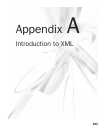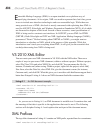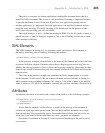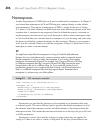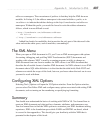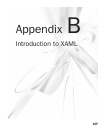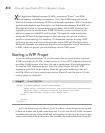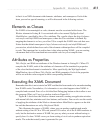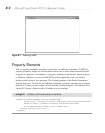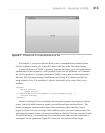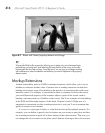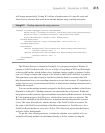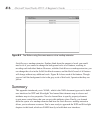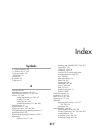
410 Microsoft Visual Studio 2010: A Beginner’s Guide
X
ML Application Markup Language (XAML), pronounced “Zamel,” is an XML-
based language for building user interfaces. You’ll find XAML being used in both
Windows Presentation Foundation (WPF) and Silverlight applications. WPF is for desktop
application development, and Silverlight is for Web-based development. Both WPF and
Silverlight have much in common through programming with XAML. Therefore, this
Appendix provides an introduction to XAML and shows you how to perform layouts,
which are common to both WPF and Silverlight. This Appendix can be useful before
reading the WPF and Silverlight chapters so that you can get the most out of what is
specific to each technology. For simplicity, I’ll demonstrate concepts by using a WPF
application, but what you learn will be applicable to both WPF and Silverlight. Before
reading this Appendix, you might want to read or review Appendix A for an introduction
to XML, which will provide you with familiarity of basic XML syntax.
Starting a WPF Project
As you are reading a book about VS, it’s only natural that you would want to experience
XAML from within the VS IDE. As stated earlier, we’ll use a WPF Application project for
describing XAML because it has fewer files and is simpler than a Silverlight application.
To create the WPF Application project, select File | New | Project and select WPF
Application in the New Project window. Name the application anything you like and
click OK. What you’ll see is a new project that has Window1.xaml file open in VS with
contents similar to Listing B-1.
Listing B-1 A new XAML file
<Window x:Class="WpfApplication1.MainWindow"
xmlns="http://schemas.microsoft.com/winfx/2006/xaml/presentation"
xmlns:x="http://schemas.microsoft.com/winfx/2006/xaml"
Title="MainWindow" Height="350" Width="525">
<Grid>
</Grid>
</Window>
In VS, the default layout for Window1.xaml is to have a visual designer on the top half
of the work window and XAML in the lower half. You can view the full XAML document
by grabbing the top edge of the XAML half and dragging it to the top of the screen so that
you are only looking at the XAML editor. The first thing you should notice about Listing B-1




